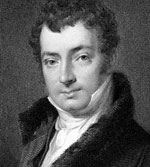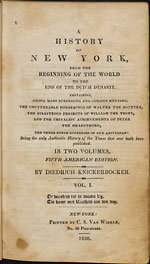A History of New York
Diedrich Knickerbocker turns 200, but where’s the party? by Rebecca Rego Barry
This year New York has been fascinated by its own history, celebrating the quadricentennial of New York’s “discovery” with replica ships, festivals, exhibits, commemorative flags, even the opening of the world’s longest elevated walkway. Hudson, Champlain and Fulton were the main honorees. But, one wonders, where’s Washington Irving, New York’s first historian?
Irving—a writer perhaps more widely known for his “Rip Van Winkle” or headless horseman—published A History of New York, from the beginning of the world to the end of the Dutch dynasty on Dec. 6, 1809. It was a widely read satirical account of the founding of New York by Dutch settlers. Although comic in tone, the two-volume book appeared at an auspicious time in New York’s history—when there was very little written documentation of New York’s history.
Elizabeth L. Bradley, deputy director of the Cullman Center for Scholars and Writers at the New York Public Library and author of the recent book, Knickerbocker: The Myth Behind New York (Rutgers University Press, 2009), writes that New York was in the middle of an identity crisis, and post-Revolutionary New Yorkers had no sense of their heritage. Then along came Irving, born of Scottish immigrants in New York City, with a book (cheekily dedicated to the newly established New York Historical Society) that purported to chronicle New York’s early years.
According to Irving’s biographer Andrew Burstein, “The complexity of Washington Irving’s humor makes his History something more than mere whimsy. Scouring libraries, private and public, he pieced together the early-to mid-seventeenth century.”
The book proved immensely popular, though some Dutch (both then and now) rejected Irving’s portrayal of lackadaisical, pipe-smoking forbearers. But many New Yorkers, Bradley said in a recent interview, were eager to find a set of ancestors that seemed more tolerant than the British. A History of New York “was so riotously funny and bawdy and topical and politically uncorrect. It filled a real void for New Yorkers,” she said.
That doddering Dutchman Diedrich Knickerbocker, the book’s fictional narrator, struck a chord with New Yorkers, and he began to take on a life of his own. Bradley’s book traces Knickerbocker’s evolving role as New York’s “spokesman;” he signified an “authentic connection” to the city, and his name was used to brand steamboat companies, to sell beer and bread, and to represent New York’s top 400 families. Even today, streets and clubs in the Big Apple remind passersby of Irving’s icon. Basketball fans evoke old Knickerbocker every time they watch the Knicks play.
“New York is still imbued with Knickerbocker, and his name hovers at the edges of everyday life, all over New York City,” writes Bradley.
But the bicentennial of this esteemed mascot has gone largely unnoticed. There were a few events tied to the publication of Bradley’s book in the late summer and early fall, and Wayne Wright, associate director of the research library at the New York State Historical Association (NYSHA) in Cooperstown, NY, did some readings from the book earlier this year. Irving’s former home, Sunnyside in Tarrytown, NY, has no special events planned to celebrate Knickerbocker’s 200th birthday. Of the handful of research institutions in the state that own a first edition of Irving’s History (Inskeep & Bradford, 1809), only the New York Historical Society and NYSHA plan to display the book this month. The New York Public Library, which holds an extensive Irving archive, loaned materials to the Patronato de la Alhambra y el Generalife in Granada for its major Irving exhibit, running through February 2010.
Irving spent many years in Europe, principally Spain, as both a writer and a diplomat. He was acquainted with presidents, kings, and other writers, such as Sir Walter Scott and Charles Dickens. Widely considered America’s first famous author, Irving won numerous honorary awards and degrees, and he served ten years as the first president of the Astor Library, forerunner of the NYPL.
Bradley speculated that Irving’s History simply got “lost in the quadricentennial.” Karen Kelleher, a writer and filmmaker who is currently finishing a documentary about Irving’s literary journey, said she believes Irving and his stories have shared in the limelight during New York’s yearlong fête.
“Irving got thrown into the mix, rather than ignored,” she said. “He got celebrated within the texture of the quad.”
Kelleher explained that Irving’s book popularized the Dutch with its comic depictions—“you are more likely to laugh along with them than judge them,” she said—and that it was his History that extended the Dutch influence in New York. “He gave life to the Dutch in a remarkable way,” she added.
Incidentally, Irving breathed life into another Dutch custom that certainly will get its fair share of celebration this month. A History of New York was published on Dec. 6, St. Nicholas Day, the day that Dutch New Yorkers honored Sancte Claus. Irving’s St. Nick was a minor character that developed as he revised A History for subsequent editions, capitalizing on the emerging Christmas traditions. He furthered these by publishing several Christmas stories in 1820, later collected in The Sketch Book of Geoffrey Crayon, Gent.










